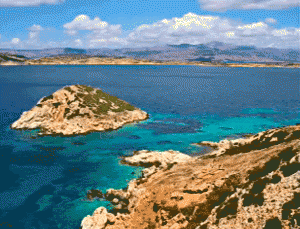Keros is located just 2 nautical miles south of Koufonissi, west of Amorgos and southeast of Naxos.
It belongs to the municipality of Koufonissia.
It has an area of 15,042 square kilometres with a coastline of 27 kilometres.
It is an important archaeological site. Excavations have brought to light finds of the Early Cycladic period 3200-2000 BC.
A characteristic stone of the island is its white fine grain marble.
It has no drinkable water.
You may visit it in your own boat or by hiring the excursion boat. However, you may not stay overnight since this is prohibited by the Archaeological Authority.
In ancient times it was called Keria.
The first reference to the island is on a 425BC inscription bearing the names of taxed allies of the Democracy of Athens. The inscription reveals that the island was inhabited during the Classical Age.

In medieval times, Keros as well as the Koufonissia were used as a safe harbour by pirates.
In 1884 archaeologist U. Kohler announces the finding of the now famous marble statuettes of the Harp Player and the Flute Player, as well as two marble statuettes of women with arms folded across the chest, definitive specimens of the Early Cycladic period. The finds are exhibited in the National Archaeological Museum.
In 1952 ownership of the island is transferred to the Monastery of the Virgin Mary Hozoviotissa of Amorgos.

In the 1950s and 1960s illegal antique dealers’ activity removed a large number of statuettes of regular type, torsos and heads, marble and clay vessels, obsidian blades and other artefacts from Greece and most of them were never recovered.
Another Harp Player statuette is exhibited in the Metropolitan Museum in New York and a large head is housed in the Louvre.
In 1963 an excavation led by the Greek archaeologist Christos Doumas and a later one by Fotini Zafiropoulou on the site of Kavos Daskalio brought to light a rich collection of Early Cycladic artefacts, which, however intrigued rather than assisted archaeologists in forming further conclusions.
In 1987 further research is undertaken in a joint venture by Greek archaeologists Christos Doumas and Lila Maragou in collaboration with Cambridge Professor of Archaeology Colin Renfrew but again, though plentiful, the finds failed to lead to satisfactory conclusions.
During 2006 and 2008 the excavation continues at Kavos Daskalio under the supervision of Professor Renfrew in collaboration with Greek archaeologist Giorgos Gavalas and a numerous team. During this period finds, considered in combination with those of the earlier digs lead archaeologists to speculate upon the existence of a pancycladic temple of the Early Bronze Age.
The study of broken artefacts indicates they were deliberately fractured during religious rituals.
This lends credence to the notion of a peripheral centre for conducting religious acts at the end of 3rd millennium BC, perhaps the first centre of worship in the Aegean, perhaps the first such island centre in the world.
In 1990 and 1992 at a Sotheby’s auction in London the Museum of Cycladic Art, in cooperation with the Commercial Bank of Greece succeeds in bringing back 81 pieces, now exhibited in the museum.
Some items from the Thesaurus of Keros are also exhibited at the Archaeological Museum of Naxos.
Excavations continue.
Keros has been uninhabited since 1968.
If you observe Keros from Pano Koufonissi on full moon nights you will notice that the outline of the ridge forms the figure of a reclining pregnant woman her head touching that of a bearded man whose torso is also visible.
The Thesaurus of Keros was recently studied by the Curator of the Museum off Cycladic Art Dr P. Sotirakopoulou and her results Re pubished in a paper entitled The thesaurus of Keros, myth or reality. In search of the lost pieces from an enigmatic whole (Athens 2005).
See Also:


